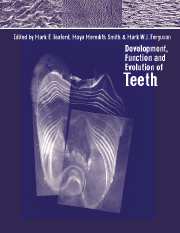Book contents
- Frontmatter
- Contents
- List of contributors
- Acknowledgements
- Part one Genes, molecules and tooth initiation
- 1 Homeobox genes in initiation and shape of teeth during development in mammalian embryos
- 2 Return of lost structure in the developmental control of tooth shape
- 3 Molecules implicated in odontoblast terminal differentiation and dentinogenesis
- 4 Enamel biomineralization: the assembly and disassembly of the protein extracellular organic matrix
- Part two Tooth tissues: development and evolution
- Part three Evolution of tooth shape and dentition
- Part four Macrostructure and function
- Index
1 - Homeobox genes in initiation and shape of teeth during development in mammalian embryos
Published online by Cambridge University Press: 11 September 2009
- Frontmatter
- Contents
- List of contributors
- Acknowledgements
- Part one Genes, molecules and tooth initiation
- 1 Homeobox genes in initiation and shape of teeth during development in mammalian embryos
- 2 Return of lost structure in the developmental control of tooth shape
- 3 Molecules implicated in odontoblast terminal differentiation and dentinogenesis
- 4 Enamel biomineralization: the assembly and disassembly of the protein extracellular organic matrix
- Part two Tooth tissues: development and evolution
- Part three Evolution of tooth shape and dentition
- Part four Macrostructure and function
- Index
Summary
Introduction
The past decade has seen remarkable advances in our understanding of the genetic control of embryonic development. We now know that developmental processes are initiated and controlled by interacting pathways of extracellular signalling molecules, receptors, intracellular signalling proteins and nuclear (transcription) factors. The different types of proteins (genes) that carry out these functions most often occur as members of families of related proteins characterised by possessing conserved amino acid motifs but which do not necessarily have similar functions in development. Thus for example, the transforming growth factor-beta (TGFβ) superfamily of secreted signalling proteins consists of a large family of proteins that share some homology with TGFβ, and in many cases share cell surface receptors (Kingsley, 1994). However, within this family different members have very different and specific functions in development. The bone morphogenetic protein Bmp-4, for example, probably has multiple functions as a signalling molecule in embryogenesis, including a role in lung morphogenesis, but targeted mutation of Bmp-4 (gene knock-out) shows a requirement for this protein for early mesoderm formation (Winnier et al., 1995; Bellusci et al., 1996). Bmp-7 on the other hand appears to have no direct role in mesoderm formation but is required for skeletal development (Luo et al., 1995). This illustrates a recurring theme in development where similar molecules have multiple functions, some of which overlap with other family members whereas others are unique. This almost certainly reflects the evolution of these gene families by gene duplication resulting in some shared and some unique functions.
The First of these families of developmental genes to be discovered and the one which has produced the greatest interest is that of the homeobox genes.
- Type
- Chapter
- Information
- Development, Function and Evolution of Teeth , pp. 3 - 12Publisher: Cambridge University PressPrint publication year: 2000
- 6
- Cited by



